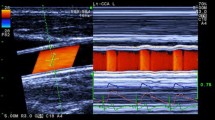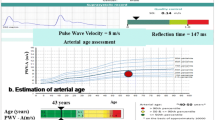Abstract.
Wave intensity (WI) is a new hemodynamic index that provides information about the dynamic behavior of the heart and the vascular system and their interaction. Carotid arterial wave intensity in normal subjects has two positive peaks. The first peak, W1, occurs during early systole, the magnitude of which increases with increases in cardiac contractility. The second peak, W2, which occurs towards the end of ejection, is related to the ability of the left ventricle to actively stop aortic blood flow. Between the two positive peaks, a negative area, NA, is often observed, which signifies reflections from the cerebral circulation. The time interval between the R-wave of ECG and the first peak (R − W1) corresponds to the pre-ejection period, and that between the first and second peaks (W1 − W2) corresponds to ejection time. We developed a new ultrasonic on-line system for obtaining WI and arterial stiffness (β). The purpose of this study was (1) to report normal values of various indices derived from WI and β measured with this system, and (2) to evaluate the intraobserver and interobserver reproducibility of the measurements. The measurement system is composed of a computer, a WI unit, and an ultrasonic machine. The WI unit gives the instantaneous change in diameter of the artery and the instantaneous mean blood velocity through the sampling gate. Using these parameters and blood pressure measured with a cuff-type manometer, the computer gives WI and β. We applied this method to the carotid artery in 135 normal subjects. The mean values of W1, W2, NA, R − W1, and W1 − W2 were 8 940 ± 3 790 mmHg m/s3, 1 840 ± 880 mmHg m/s3, 27 ± 13 mmHg m/s2, 104 ± 14 ms, and 270 ± 19 ms, respectively. These values did not show a significant correlation with age. The mean value of β was 10.4 ± 4.8 and the values significantly correlated with age (men: r = 0.66, P < 0.0001; women: r = 0.81, P < 0.0001). The reproducibility was evaluated by intraobserver intrasession (IA), intraobserver intersession (IE), and interobserver intrasession variability (IO). The reproducibility of R − W1 and W1 − W2 was high: the mean coefficient of variation (mCV) of IA was less than 3%; 95% confidence limits from the mean values (CL) were less than 8% for IE and less than 4% for IO. The reproducibility of W1 and β was good: mCV for IA was less than 10%; CL for IE and IO were less than 17%. W2 and NA showed a higher variability than other indices: mCV for IA was less than 13%, and CL for IE and IO were less than 36%. However, two sessions by the same observer and two sessions by different observers were not biased. Wave intensity measurements with this system are clinically acceptable.
Similar content being viewed by others
Author information
Authors and Affiliations
Additional information
Received: March 25, 2002 / Accepted: June 17, 2002
Acknowledgments K.N. and M.S. were supported by Grants-in-Aid for Scientific Research (B)-11695092 and (C)-11670713 from the Ministry of Education, Science, Sports and Culture of Japan.
Correspondence to K. Niki
Rights and permissions
About this article
Cite this article
Niki, K., Sugawara, M., Chang, D. et al. A new noninvasive measurement system for wave intensity: evaluation of carotid arterial wave intensity and reproducibility. Heart Vessels 17, 12–21 (2002). https://doi.org/10.1007/s003800200037
Issue Date:
DOI: https://doi.org/10.1007/s003800200037




